Optimal Design of an Hourglass in-Fiber Air Fabry-Perot Microcavity—Towards Spectral Characteristics and Strain Sensing Technology
Abstract
:1. Introduction
2. Sensor Structure and Sensing Principle
2.1. Sensor Structure
2.2. Sensing Principle
3. Optimal Design of the Hourglass Microcavity Sensor
3.1. Influence of Microcavity Structure Parameters on Spectral Characteristics
3.2. Influence of Microcavity Structure Parameters on Strain Sensing Characteristics
4. Sensing Properties of the Hourglass Optical Microcavity Sensor
5. Conclusions
Acknowledgments
Author Contributions
Conflicts of Interest
References
- Xu, F.; Peng, B.; Chen, D.; Wang, L.; Lei, X.; Shi, Q. A novel strain sensor based on a dual-core photonic crystal fiber. Microwave Opt. Technol. Lett. 2014, 56, 2778–2780. [Google Scholar] [CrossRef]
- Wang, Y.; Shen, C.; Lou, W.; Wang, Y.; Shen, C.; Lou, W.; Shentu, F. Intensity modulation type fiber-optic strain sensor based on a Mach–Zehnder interferometer constructed by an up-taper with a LPG. Opt. Commun. 2016, 364, 72–75. [Google Scholar] [CrossRef]
- Wu, Z.; Zhang, H.; Shum, P.P.; Shao, X.; Huang, T.; Seow, Y.M.; Liu, Y.G.; Wei, H.; Wang, Z. Supermode Bragg grating combined Mach-Zehnder interferometer for temperature-strain discrimination. Opt. Express 2015, 23, 33001. [Google Scholar] [CrossRef] [PubMed]
- Roriz, P.; Carvalho, L.; Frazão, O.; Santos, J.L.; Simões, J.A. From conventional sensors to fibre optic sensors for strain and force measurements in biomechanics applications: A review. J. Biomech. 2014, 47, 1251. [Google Scholar] [CrossRef] [PubMed]
- Kinet, D.; Mégret, P.; Goossen, K.W.; Liang, Q.; Heider, D.; Caucheteur, C. Fiber Bragg Grating Sensors toward Structural Health Monitoring in Composite Materials: Challenges and Solutions. Sensors 2014, 14, 7394–7419. [Google Scholar] [CrossRef] [PubMed]
- Ramakrishnan, M.; Rajan, G.; Semenova, Y.; Farrell, G. Overview of Fiber Optic Sensor Technologies for Strain/Temperature Sensing Applications in Composite Materials. Sensors 2016, 16, 99. [Google Scholar] [CrossRef] [PubMed]
- Ye, X.W.; Su, Y.H.; Han, J.P. Structural health monitoring of civil infrastructure using optical fiber sensing technology: A comprehensive review. Sci. world J. 2014, 2014, 652329. [Google Scholar] [CrossRef] [PubMed]
- Leung, C.K.Y.; Wan, K.T.; Inaudi, D.; Bao, X.; Habel, W.; Zhou, Z.; Ou, J.; Ghandehari, M.; Wu, H.C.; Imai, M. Review: Optical fiber sensors for civil engineering applications. Mater. Struct. 2015, 48, 871–906. [Google Scholar] [CrossRef]
- Wu, R.; Zheng, B.; Fu, K.; He, Pe.; Tan, Y. Study on strain transfer of embedded fiber Bragg grating sensors. Opt. Eng. 2014, 53, 085105. [Google Scholar] [CrossRef]
- Wang, Y.; Qiao, X.; Yang, H.; Su, D.; Li, L.; Guo, T. Sensitivity-Improved Strain Sensor over a Large Range of Temperatures Using an Etched and Regenerated Fiber Bragg Grating. Sensors 2014, 14, 18575–18582. [Google Scholar] [CrossRef] [PubMed]
- Shin, W.; Lee, Y.L.; Yu, B.A.; Noh, Y.C.; Ahn, T.J. Highly sensitive strain and bending sensor based on in-line fiber Mach–Zehnder interferometer in solid core large mode area photonic crystal fiber. Opt. Commun. 2010, 283, 2097–2101. [Google Scholar] [CrossRef]
- Sun, M.; Xu, B.; Dong, X.; Li, Y. Optical fiber strain and temperature sensor based on an in-line Mach–Zehnder interferometer using thin-core fiber. Opt. Commun. 2012, 285, 3721–3725. [Google Scholar] [CrossRef]
- Kunert, D.M.B.; Meyrath, T.P.; Giessen, H. Fabrication of a fiber-based microcavity with spherical concave fiber tips. Appl. Phys. B 2010, 98, 707–710. [Google Scholar] [CrossRef]
- Liu, S.; Wang, Y.; Liao, C.; Wang, G.; Li, Z.; Wang, Q.; Zhou, J.; Yang, K.; Zhong, X.; Zhao, J.; et al. High-sensitivity strain sensor based on in-fiber improved Fabry-Perot interferometer. Opt. Lett. 2014, 39, 2121–2124. [Google Scholar] [CrossRef] [PubMed]
- Zhang, Y.; Yuan, L.; Lan, X.; Kaur, A.; Huang, J.; Xiao, H. High-temperature fiber-optic Fabry-Perot interferometric pressure sensor fabricated by femtosecond laser: erratum. Opt. Lett. 2013, 38, 4609–4612. [Google Scholar] [CrossRef] [PubMed]
- Wei, T.; Han, Y.; Tsai, H.L.; Xiao, H. Miniaturized fiber inline Fabry-Perot interferometer fabricated with a femtosecond laser. Opt. Lett. 2008, 33, 536. [Google Scholar] [CrossRef] [PubMed]
- Steinmetz, T.; Colombe, Y.; Hunger, D.; Haensch, D.; Balocchi, A.; Warburton, R.; Reichel, J. Stable fiber-based Fabry-Pérot cavity. Appl. Phys. Lett. 2006, 89, 127. [Google Scholar] [CrossRef]
- Hunger, D.; Steinmetz, T.; Colombe, Y.; Deutsch, C.; Theodor, W.; Haensch, D.; Reichel, J. Fiber Fabry-Perot cavity with high finesse. New J. Phys. 2010, 12, 065038. [Google Scholar] [CrossRef]
- Flowers-Jacobs, N.E.; Hoch, S.W.; Sankey, J.C.; Kashkanova, A. Fiber-cavity-based optomechanical device. Appl. Phys. Lett. 2012, 101, 1693. [Google Scholar] [CrossRef]
- Greuter, L.; Starosielec, S.; Najer, D.; Ludwig, A.; Duempelmann, L.; Rohner, D.; Warburton, R.J. A small mode volume tunable microcavity: Development and characterization. Appl. Phys. Lett. 2014, 105, 839. [Google Scholar] [CrossRef]
- Cibula, E.; Donlagic, D. In-line short cavity Fabry-Perot strain sensor for quasi distributed measurement utilizing standard OTDR. Opt. Express 2007, 15, 8719–8730. [Google Scholar] [CrossRef] [PubMed]
- Rao, Y.J.; Deng, M.; Duan, D.W.; Yang, X.C.; Zhu, T.; Cheng, G.H. Micro Fabry-Perot interferometers in silica fibers machined by femtosecond laser. Opt. Express 2007, 15, 14123–14128. [Google Scholar] [CrossRef]
- Duan, D.W.; Rao, Y.J.; Hou, Y.S.; Zhu, T. Microbubble based fiber-optic Fabry–Perot interferometer formed by fusion splicing single-mode fibers for strain measurement. Appl. Opt. 2012, 51, 1033. [Google Scholar] [CrossRef] [PubMed]
- Ferreira, M.S.; Bierlich, J.; Kobelke, J.; Schuster, K.; Santos, J.L.; Frazão, O. Towards the control of highly sensitive Fabry-Pérot strain sensor based on hollow-core ring photonic crystal fiber. Opt. Express 2012, 20, 21946–21952. [Google Scholar] [CrossRef] [PubMed]
- Liao, C.R.; Wang, D.N.; Wang, Y. Microfiber in-line Mach-Zehnder interferometer for strain sensing. Opt. Lett. 2013, 38, 757–759. [Google Scholar] [CrossRef] [PubMed]
- Rao, Y.J.; Deng, M.; Duan, D.W.; Yang, X.C.; Zhu, T.; Cheng, G.H. Microcavity strain sensor for high temperature applications. Opt. Eng. 2014, 53, 017105. [Google Scholar] [CrossRef]
- Dusseiller, M.; Schlaepfer, D.; Koch, M.R.; Textor, M. An inverted microcontact printing method on topographically structured polystyrene chips for arrayed micro-3-D culturing of single cells. Biomaterials 2005, 26, 5917–5925. [Google Scholar] [CrossRef] [PubMed]
- Wang, A.; He, S.; Fang, X.; Jin, X.; Lin, J. Optical fiber pressure sensor based on photoelasticity and its application. IEEE J. Lightwave Technol. 1992, 10, 1466–1472. [Google Scholar] [CrossRef]
- Ogura, H.; Yoshida, Y. Cavity Theory of Fabry Perot Resonator. Jpn. J. Appl. Phys. 1964, 3, 546. [Google Scholar] [CrossRef]
- Qing, M.A.; Wang, M.J.; Ying-Le, L.I.; Meng, X.H.; Hua, M.A. The Fresnel Formula of Different Incidence Polarized Waves on the Moving Interface of Left-Handed Medium Interface. J. Anhui Normal Univ. 2013, 36, 36–40. [Google Scholar]
- Liu, S.; Yang, K.; Wang, Y.; Qu, J.; Liao, C.; He, J.; Li, Z.; Yin, G.; Sun, B.; Zhou, J.; et al. High-sensitivity strain sensor based on in-fiber rectangular air bubble. Sci. Rep. 2015, 5, 7624. [Google Scholar] [CrossRef] [PubMed]
- Chen, D.; Luo, S.; Ma, X.; Jiang, X.; Feng, G.; Yang, J. Fiber-tip bubble-structure microcavity sensor. Adv. Sens. Syst. Appl. VI 2014, 9274, 927414–927417. [Google Scholar]
 ) (a) F-P cavity with rectangular reflector; (b) F-P cavity with concave mirror; (c,d) Hourglass in-fiber air Fabry-Perot Microcavity.
) (a) F-P cavity with rectangular reflector; (b) F-P cavity with concave mirror; (c,d) Hourglass in-fiber air Fabry-Perot Microcavity.
 ) (a) F-P cavity with rectangular reflector; (b) F-P cavity with concave mirror; (c,d) Hourglass in-fiber air Fabry-Perot Microcavity.
) (a) F-P cavity with rectangular reflector; (b) F-P cavity with concave mirror; (c,d) Hourglass in-fiber air Fabry-Perot Microcavity.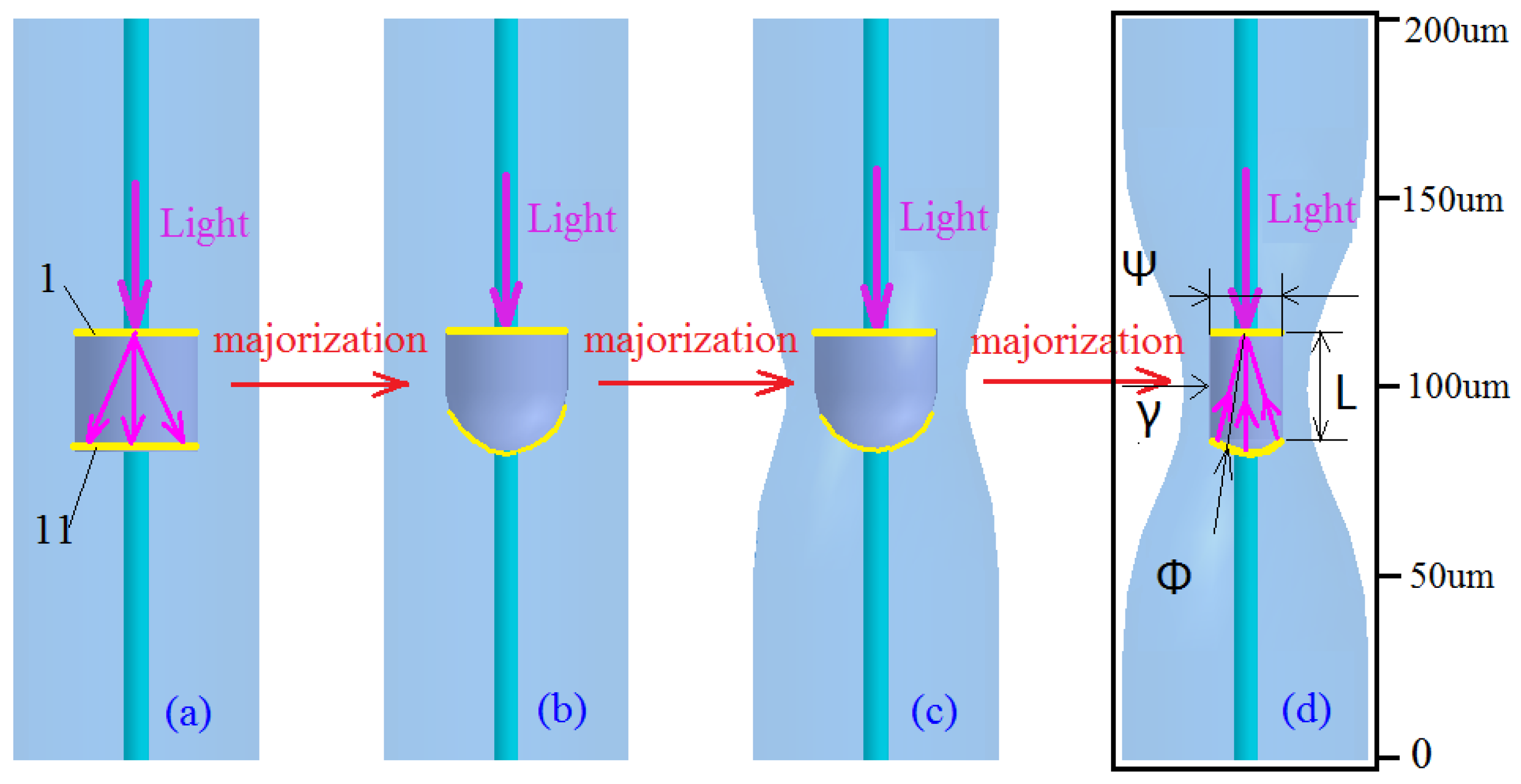
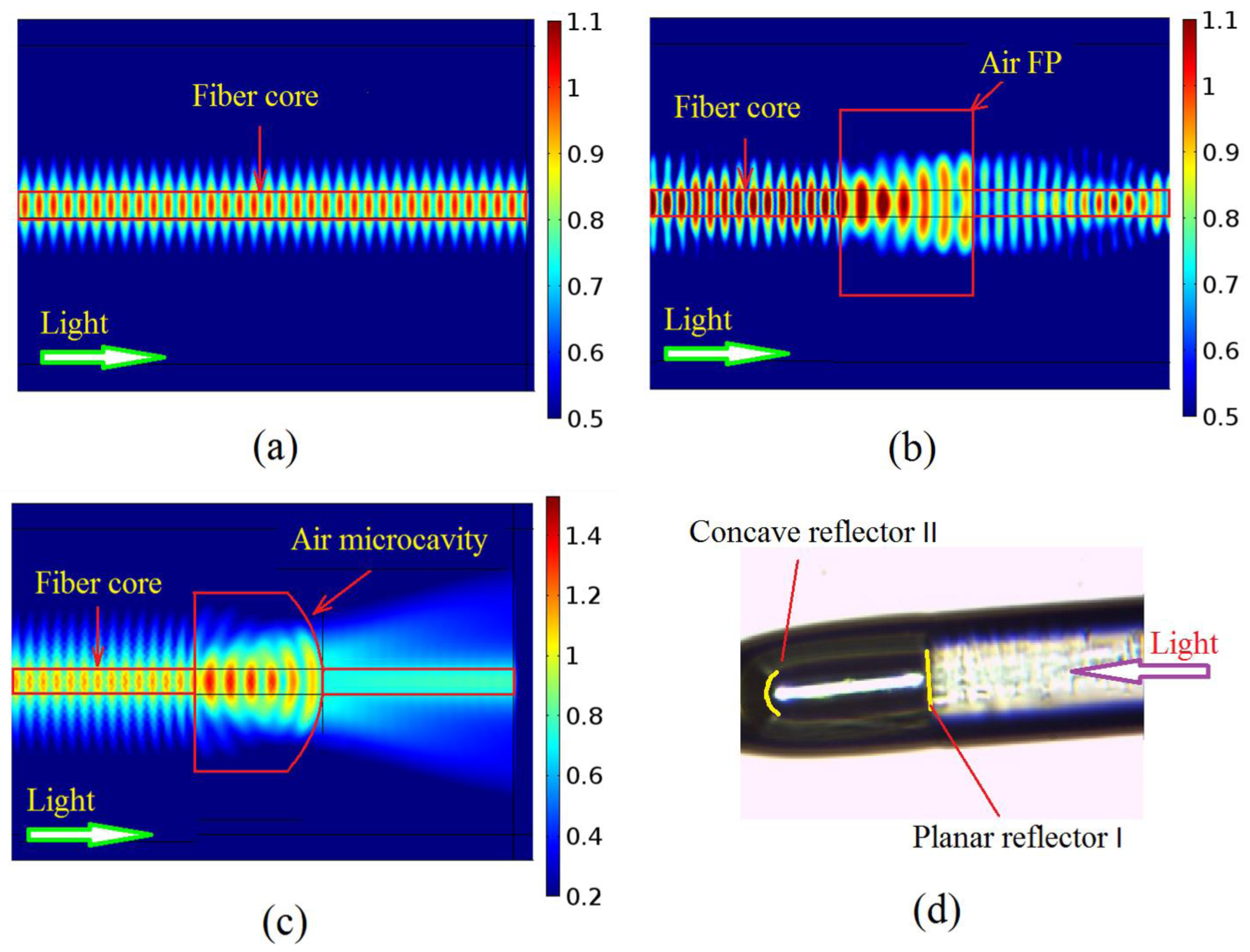
 .)
.)
 .)
.)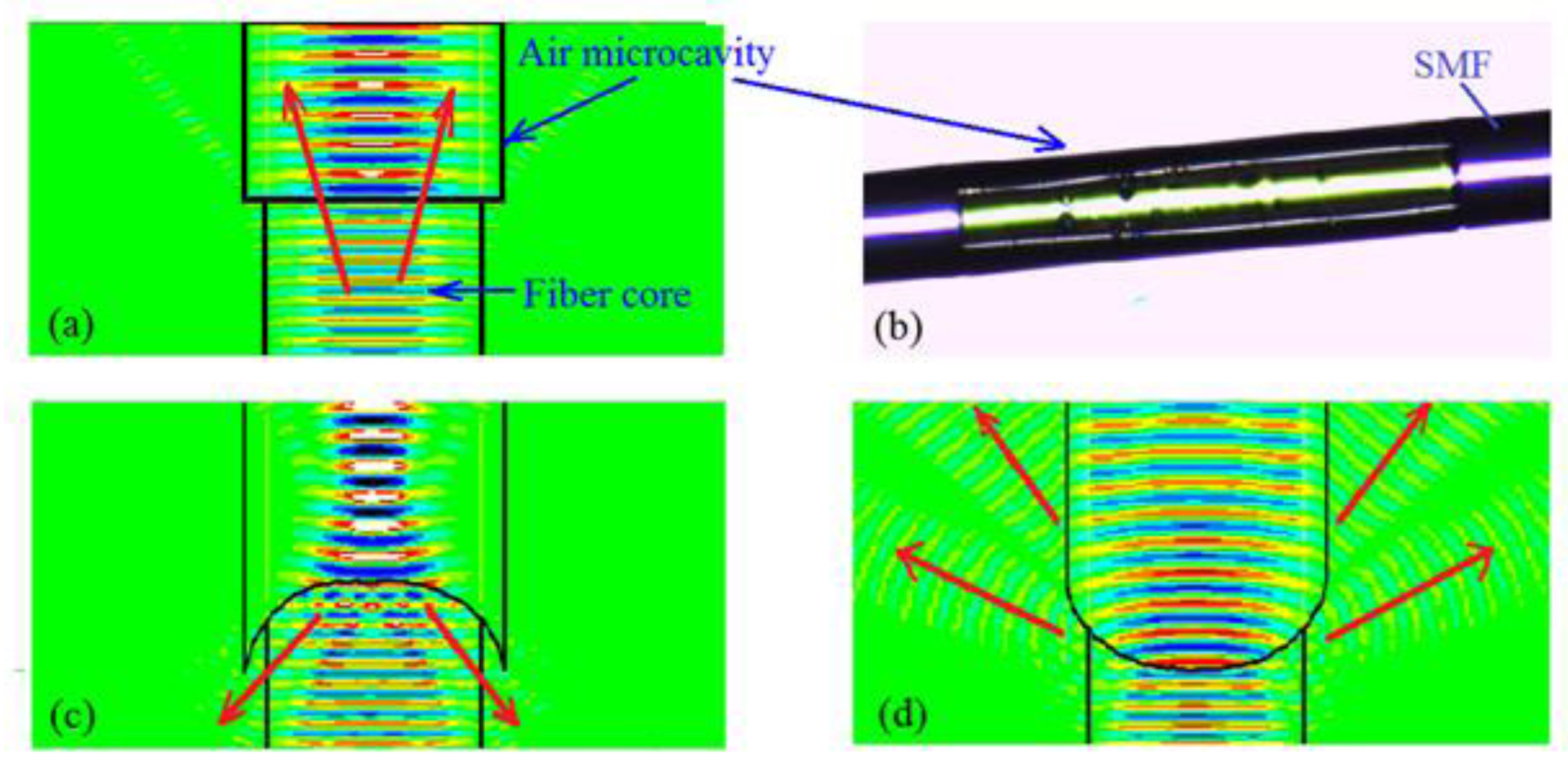
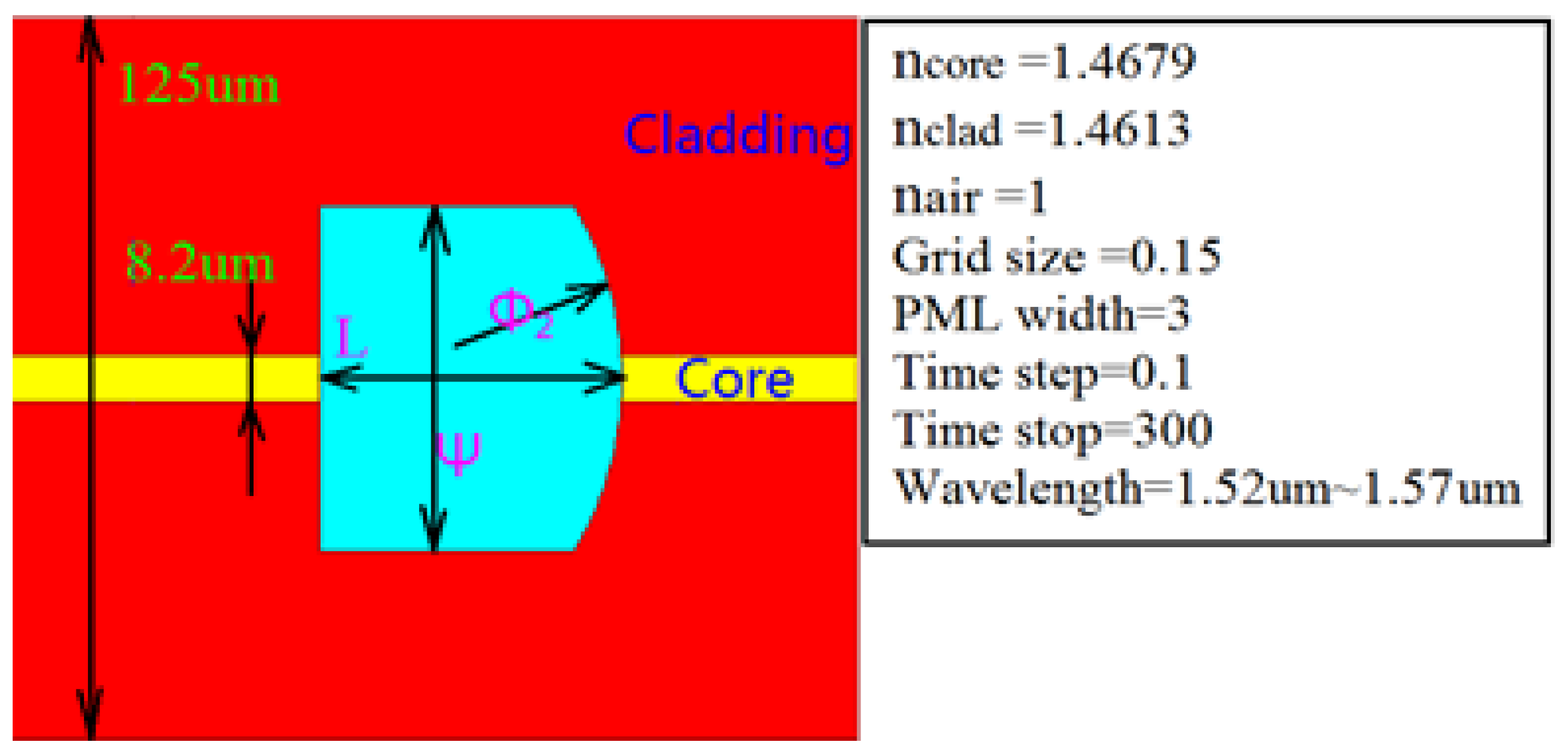

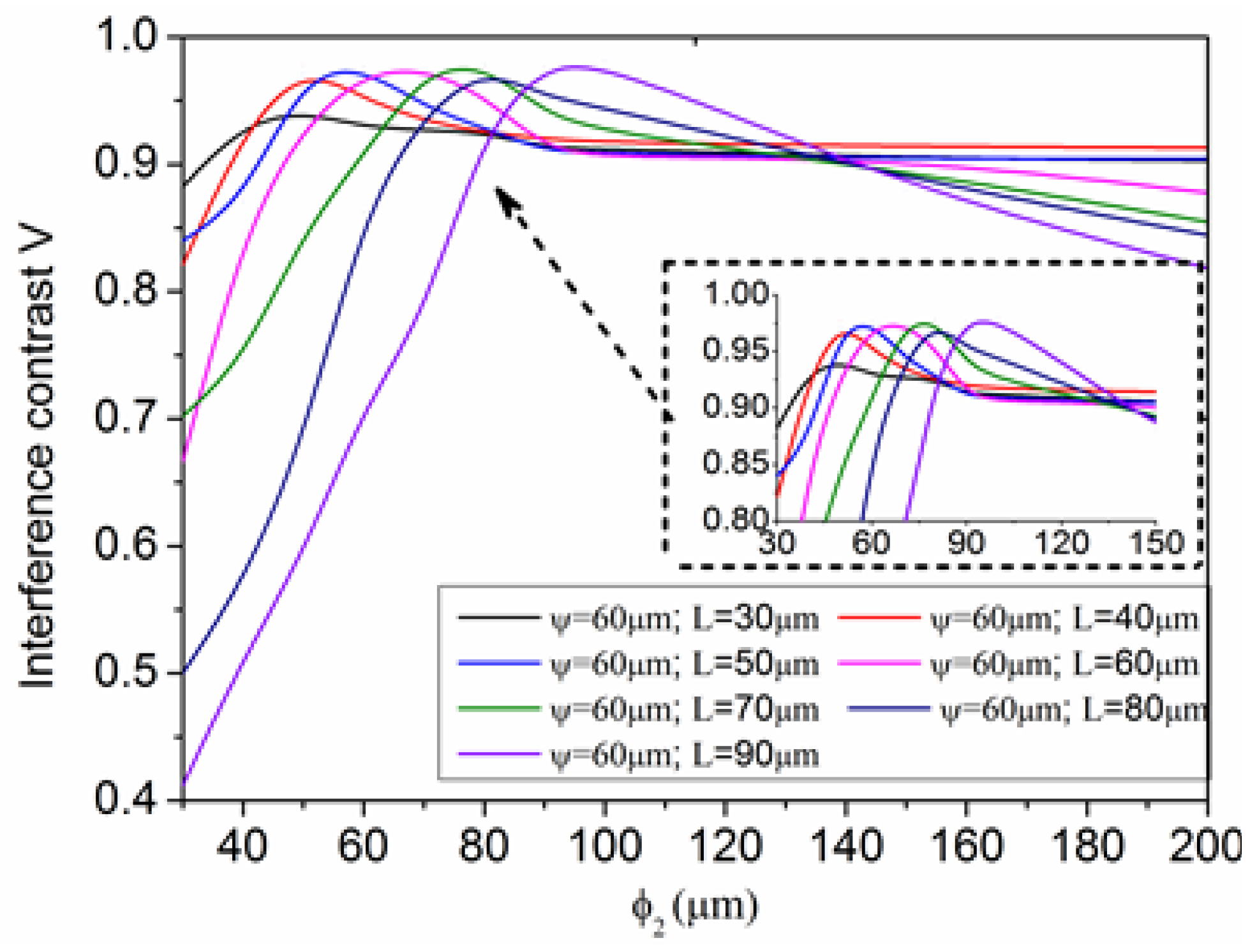
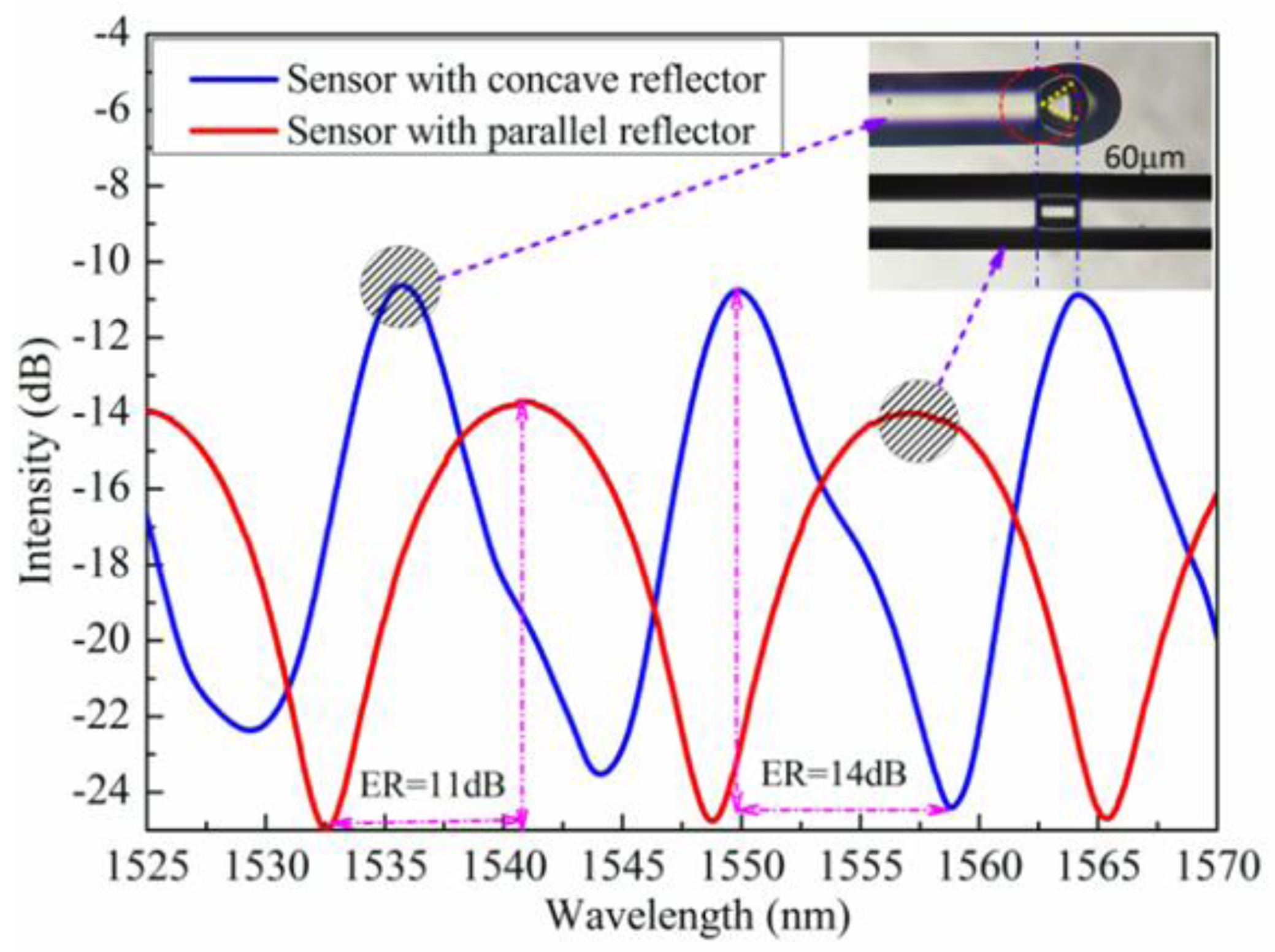

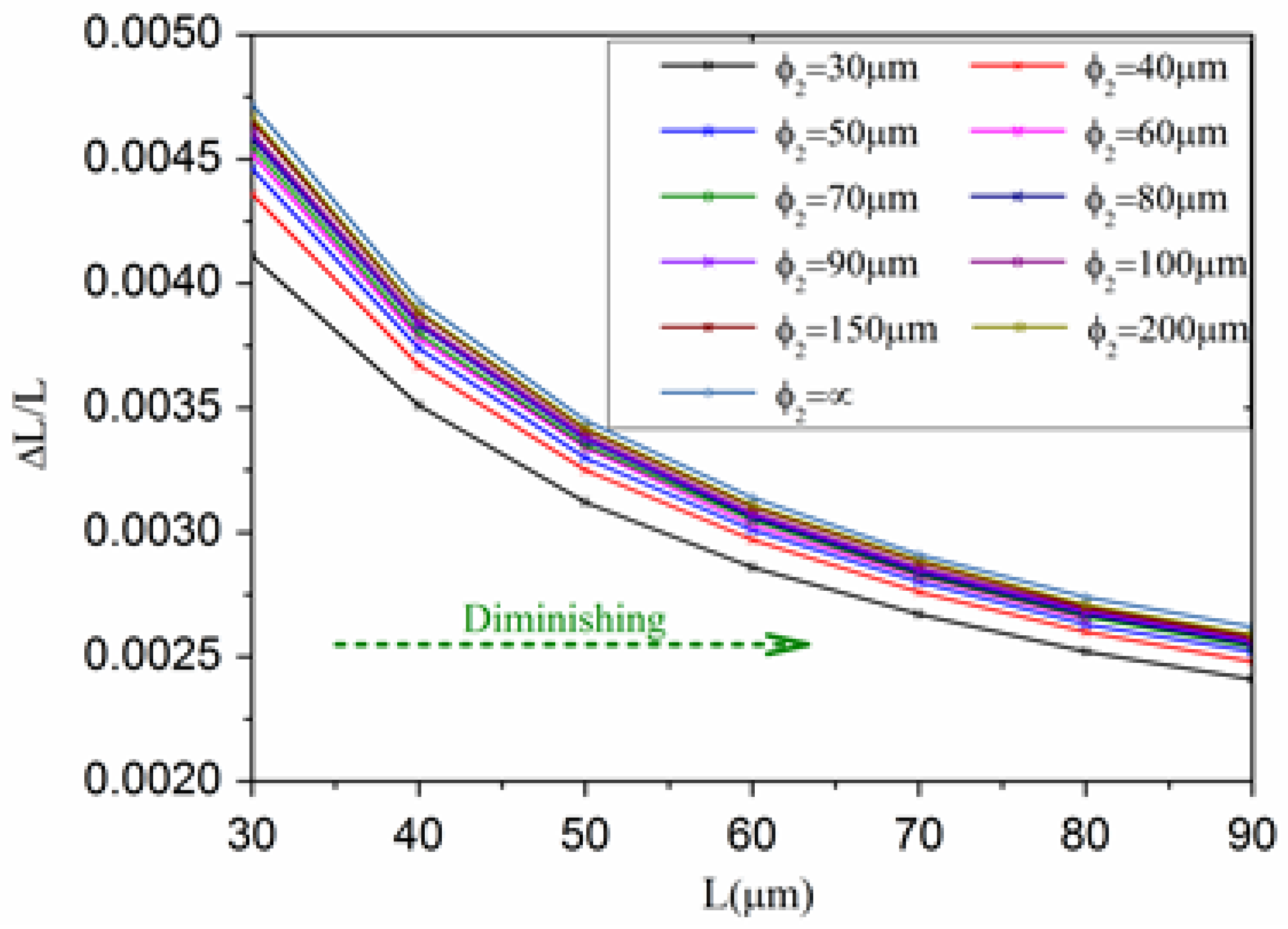
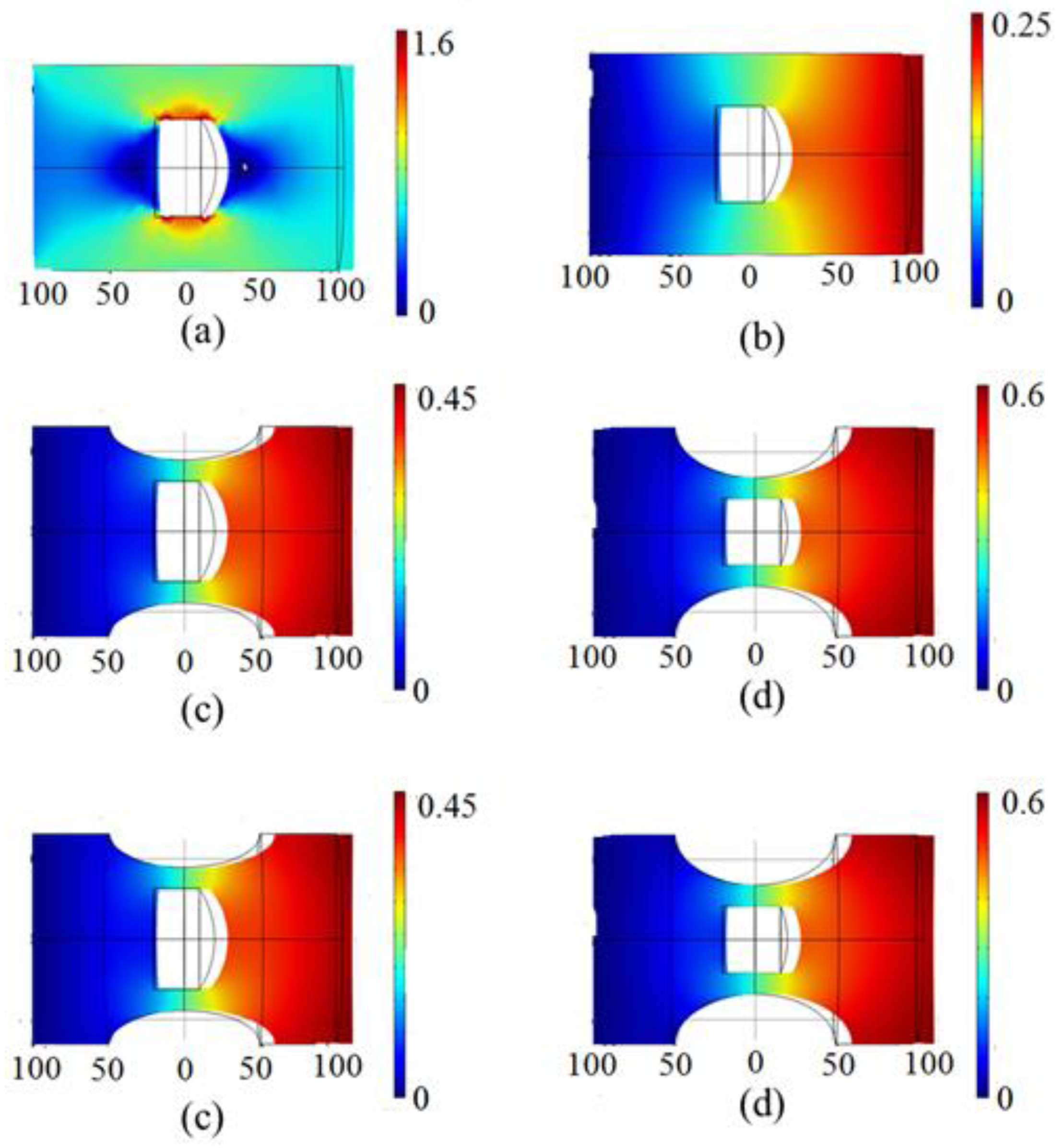
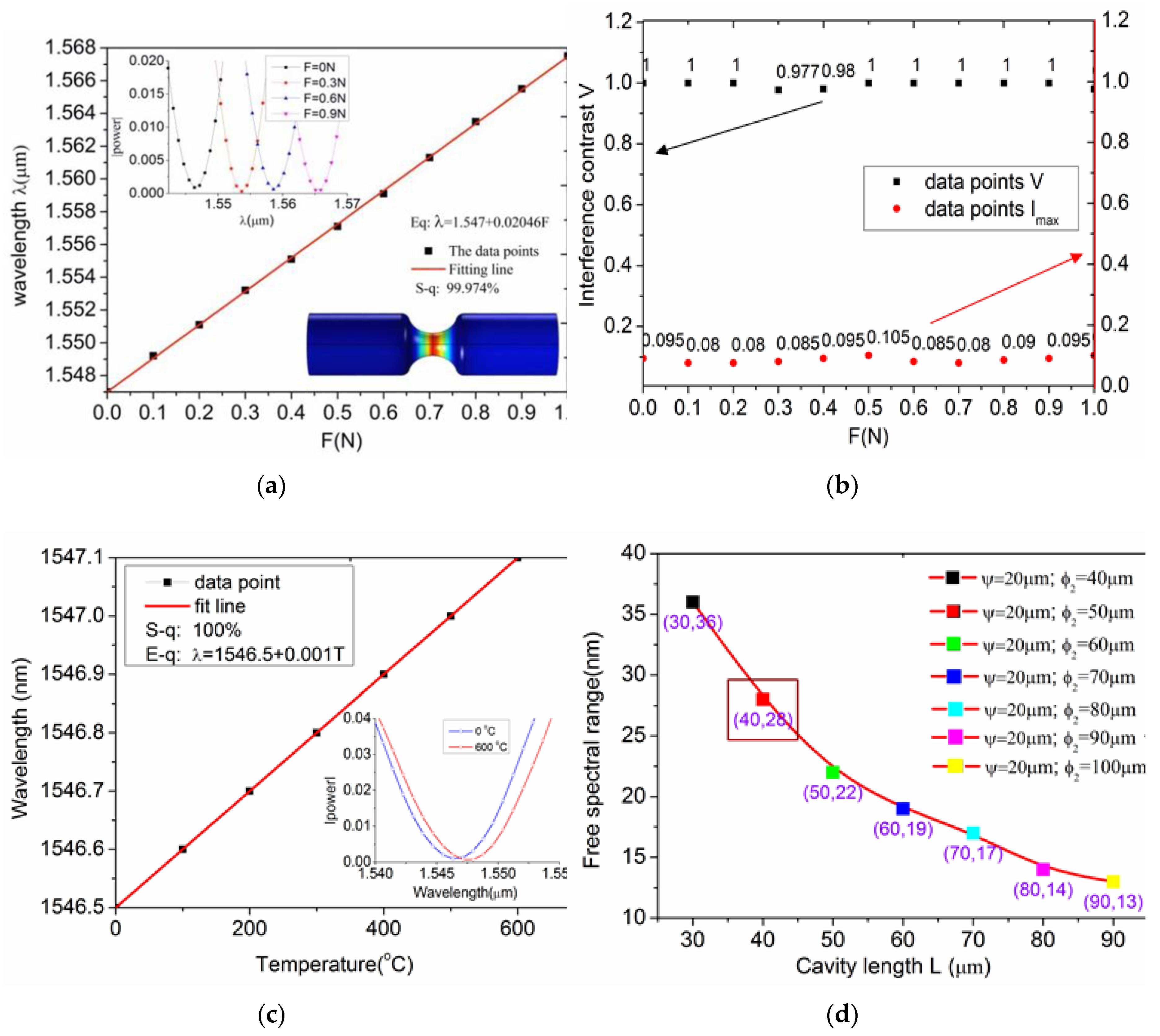
© 2017 by the authors. Licensee MDPI, Basel, Switzerland. This article is an open access article distributed under the terms and conditions of the Creative Commons Attribution (CC BY) license (http://creativecommons.org/licenses/by/4.0/).
Share and Cite
Wang, Q.; Yan, D.; Cui, B.; Guo, Z. Optimal Design of an Hourglass in-Fiber Air Fabry-Perot Microcavity—Towards Spectral Characteristics and Strain Sensing Technology. Sensors 2017, 17, 1282. https://doi.org/10.3390/s17061282
Wang Q, Yan D, Cui B, Guo Z. Optimal Design of an Hourglass in-Fiber Air Fabry-Perot Microcavity—Towards Spectral Characteristics and Strain Sensing Technology. Sensors. 2017; 17(6):1282. https://doi.org/10.3390/s17061282
Chicago/Turabian StyleWang, Qi, Dongchao Yan, Binbin Cui, and Zixuan Guo. 2017. "Optimal Design of an Hourglass in-Fiber Air Fabry-Perot Microcavity—Towards Spectral Characteristics and Strain Sensing Technology" Sensors 17, no. 6: 1282. https://doi.org/10.3390/s17061282
APA StyleWang, Q., Yan, D., Cui, B., & Guo, Z. (2017). Optimal Design of an Hourglass in-Fiber Air Fabry-Perot Microcavity—Towards Spectral Characteristics and Strain Sensing Technology. Sensors, 17(6), 1282. https://doi.org/10.3390/s17061282






